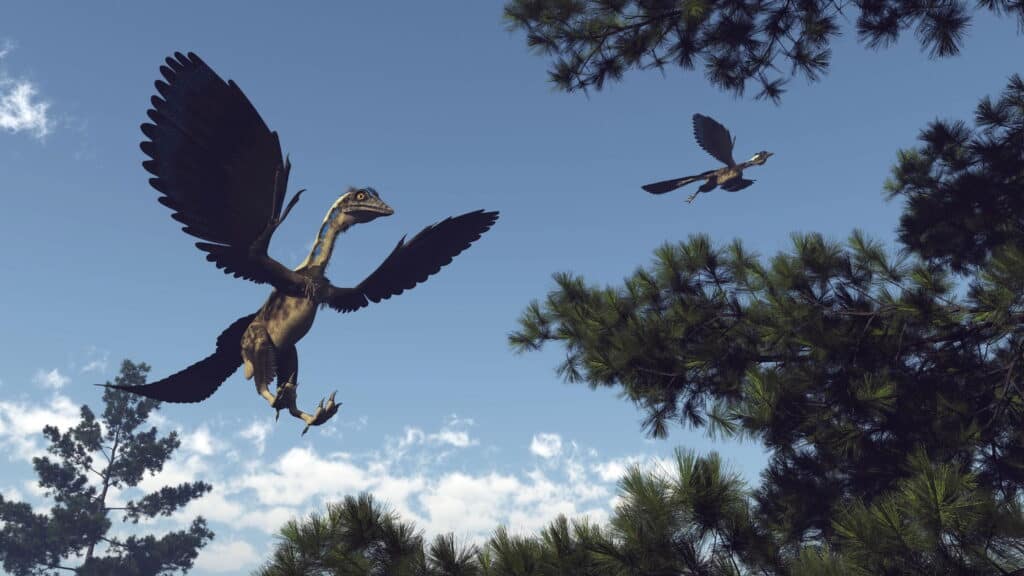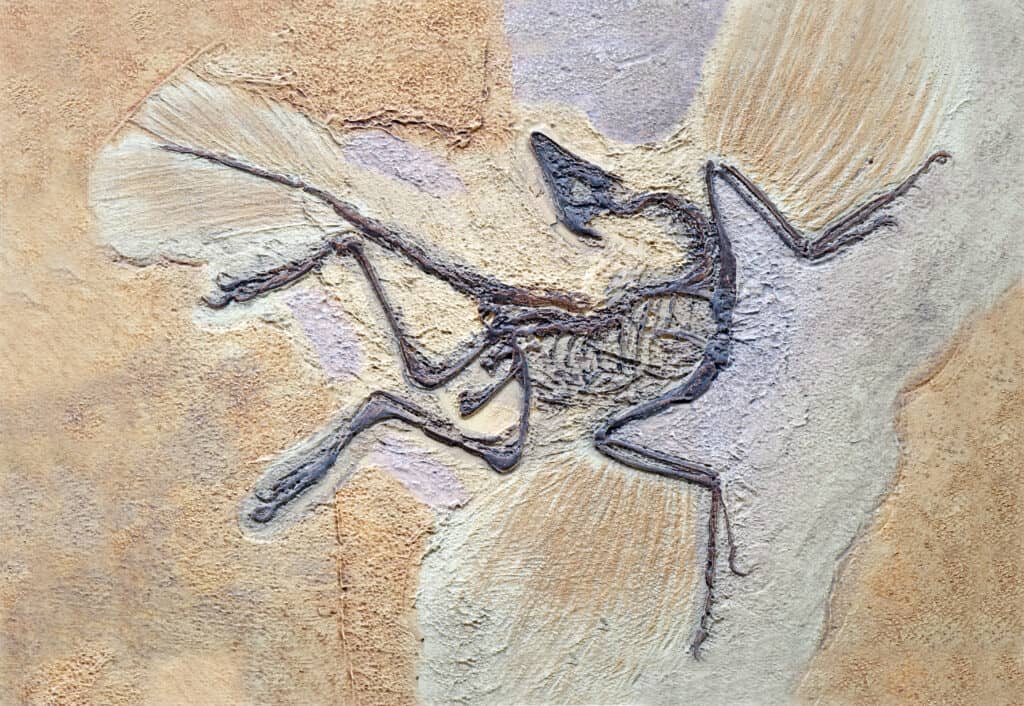Meet the Archaeopteryx, the first dinosaur that was bird-like. For a long time, there had always been a lot of debates concerning this prehistoric creature; the major one was about the Archaeopteryx being the oldest bird known.
Many paleontologists believed that the Archaeopteryx isn’t the most primitive bird but only closely related to that bird. So instead, they used it as a representation of the ancestral bird.
However, between the late 19th century and early 21st century, paleontologists began to agree with the fact that the Archaeopteryx is the oldest bird known. It also began to reflect in their reference books. Keep reading to discover some amazing things about this creature, including inspiring the name of a clothing brand.
Arc’teryx Clothing Brand
The Arc’teryx clothing brand is a Canadian design company specializing in outdoor clothing and apparel. The company derives its name (Arc’teryx) and logo from Archaeopteryx, the bird that shows the transition between early and modern dinosaurs. Arc’teryx is known to produce high-quality water-resistant shell jackets and knitwear.

Aside from being one of the earliest bird on record, Archaeopteryx also has a clothing brand named after it.
©gubernat/Shutterstock.com
Full Description and Size of the Archaeopteryx
The Archaeopteryx is believed to have existed during the late Jurassic period, and a full-grown and developed Archaeopteryx had approximately the size of a Raven. It also possessed rounded, broad wings and a tail that was as long as its entire body length.
The Archaeopteryx weighed about 1.8 lb to 2.2 lb and had a total body length of about 20 inches. The Archaeopteryx was relatively small and possessed broad wings, suggesting they could fly. However, despite all these features of modern birds that the Archaeopteryx possesses, it had more features in common with other theropod dinosaurs. It sparked a lot of debates among paleontologists who argued that the Archaeopteryx wasn’t an actual bird.
The Archaeopteryx also had some other features in common with non-avian theropod dinosaurs that existed back then. They include; jaws containing small sharp teeth, a long bony tail, fingers with claws, feathers, hyperextensible killing claws, etc. These similar features made some scientists consider the Archaeopteryx a link between birds and non-avian dinosaurs.
John Ostrom, in the 1970s, concluded that birds evolved initially from theropod dinosaurs. He made use of the Archaeopteryx as evidence to support his claim. The Archaeopteryx possessed many bird-like features, which included; a wishbone, feathers for flight, wings, etc. The Archaeopteryx also had three digits on each of its forelegs. Only birds like ducks, swans, and jacanas have this feature too.

A fully-grown Archaeopteryx was approximately the size of a raven, and had a number of dinosaur-like features, such as claws and sharp teeth.
©Elenarts/Shutterstock.com
Origin of the Name “Archaeopteryx”
Some call the Archaeopteryx “Urvogel” (its German name), which means original bird or first bird. Archaeopteryx is derived from two Greek words. They are archaīos (which means ancient) and ptéryx (which means feather or wings). Hermann von Meyer named it in 1861.
Species of the Archaeopteryx
Scientists have discovered different fossils of the Archaeopteryx at different times, and they classify these into two major species. They are A. lithographica and A. siemensii.
Diet- What Did Archaeopteryx Eat?
The Archaeopteryx is presumed to have been carnivorous. It must have fed on small reptiles, amphibians, mammals as well as insects. The jaws must have been used to hold smaller prey, while its claws must have been used to pin larger prey.
Based on fossil records, the Archaeopteryx possessed small teeth and claws, which suggests that it fed on smaller animals. Studies also show that many insects and small lizards existed in the same region and time as the Archaeopteryx.
Habitat- When and Where Did the Archaeopteryx Live?
The Archaeopteryx is believed to have existed about 150.8 million to 148.5 million years ago during the early Tithonian stage of the late Jurassic period. It is believed to have lived in what is now known as Southern Germany, in a shallow warm tropical sea that was very close to the equator. The warm climate in the region is similar to that of Florida.
The habitat of the Archaeopteryx might have been Arboreal because some scientists suggest they were gliders. And gliders are majorly tree-bound or arboreal. It is not known if the Archaeopteryx lived in pairs or groups. But it is believed that they probably lived with other animals, especially dinosaurs capable of flying.
Threats and Predators of the Archaeopteryx
The threats and predators of the Archaeopteryx aren’t known. So, they might not have been threatened so much by predators. But instead, they were predators to smaller animals like lizards and reptiles. It majorly made use of its jaws and sharp claws to achieve this.
Discoveries and Fossils: Where Archaeopteryx was Discovered?
A total of twelve specimens of fossils of the Archaeopteryx have been discovered, and all of them were discovered in limestone deposits near Solnhofen, Germany. It was first discovered as a solitary or single feather in 1860 or 1861 by Hermann von Meyer. The feather is currently being kept at the Natural History Museum of Berlin. However, there were indications that the feather was for a different animal because it was different from the morphology of other Archaeopteryx feathers.
The London specimen, the first skeleton, was discovered in 1861 near Langenaltheim, Germany. This specimen was later given to a medical doctor, Karl Häberlein, for medical services. He later sold it to the National History Museum, London, where it is found today. This specimen had most parts of its head and neck missing. The specimen also seems to support Charles Darwin’s publication “on the origin of Species.”
Another Specimen of the Archaeopteryx, known as the Berlin Specimen, was discovered in 1874 or 1875 near Eichstatt, Germany, by Jakob Niemeyer. He was a Farmer and sold the fossil in 1876 to innkeeper Johann Dörr. This specimen eventually went through various transactions till it was bought by Berlin National History Museum, where it resides today. Wilhelm Dames described this specimen as a complete specimen with a complete head.
The Haarlem Specimen was discovered in Riedenburg, Germany, in 1885. It is known to be one of the least complete Archaeopteryx specimens because it consists of limb bones, ribs, and cervical vertebrae. It is located in Teylers Museum, Haarlem, Netherlands.
Other Specimens discovered also include the Eichstätt Specimen, Solnhofen specimen, Munich specimen, Daiting specimen, Bürgermeister-Müller specimen, and the Thermopolis specimen. The 12th and final specimen were discovered in 2010 at the Schamhaupten quarry. However, this specimen was described scientifically in 2018.

The first Archaeopteryx skeleton was discovered in 1861 near Langenaltheim, Germany.
©Mark Brandon/Shutterstock.com
Extinction: When Did the Archaeopteryx Die out?
Scientists believe that the Archaeopteryx went into extinction about 150 million years ago. The actual cause of its extinction isn’t known. Several factors like changing climates and competition for food might have led to the extinction of Archaeopteryx.
Animals that Are Similar to the Archaeopteryx
The following are animals that are similar to the Archaeopteryx:
Xiaotingia
Xiaotingia lived about 155 million years ago and is a member of theropod dinosaurs. It existed during the late Jurassic period, and its deposits were found around western Liaoning, China. It existed some years before Archaeopteryx and was morphologically similar to it. The Xiaotingia had the size of a hen and weighed about 0.82 kg.
Anchiornis
The Anchiornis is an extinct four-winged paravian dinosaur similar to modern birds. The fossils were found around the Tiaojishan formation of Liaoning, China. It also existed during the late Jurassic period, about 160 million years ago.
Aurornis
The Aurornis is also a member of theropod dinosaurs during the late Jurassic period. The fossil was first unearthed in Yaoluguo in western Liaoning, China. It also existed about 160 million years ago.
Conclusion
The discovery of the Archaeopteryx was instrumental in explaining the link between dinosaurs and birds. This bird was a prehistoric phenomenon, we are not aware of how well and how far it could fly, but that must have been something to behold.
Up Next: Ancient animals have been a source of fascination for humans for several years. There is no limit to what you can learn about evolution regarding prehistoric animals. Here are some articles about prehistoric events and animals you can check out on this site
The photo featured at the top of this post is © Dotted Yeti/Shutterstock.com
FAQs (Frequently Asked Questions)
At what time did Archaeopteryx exist?
It is believed that the Archaeopteryx existed about 150.8 million to 148.5 million years ago during the early Tithonian stage of the late Jurassic period.
What was the size of the Archaeopteryx?
The Archaeopteryx weighed about 1.8 lb to 2.2 lb and had a total body length of about 20 inches.
How is Archaeopteryx Pronounced?
The word Archaeopteryx is pronounced phonetically as Ar-kay-op-teh-rix.
Could Archaeopteryx fly?
Different scientists have their opinions on this. Some believe it could fly, while others believe it could glide. However, it possessed a wishbone that suggests flapping its wings for short distances, maybe to avoid predators.
Was Archaeopteryx the First Bird to exist?
Some scientists believed that the Archaeopteryx was the first bird to exist. However, some other birds like Aurornis have been discovered. And studies show that they existed about 10 million years before Archaeopteryx.
Thank you for reading! Have some feedback for us? Contact the AZ Animals editorial team.






